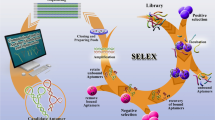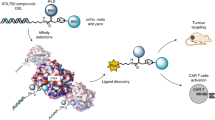Abstract
The major aim of molecular cancer research is the development of new therapeutic strategies and compounds that target directly the genetic and biochemical causes of malignant transformation. Therapeutic genes, antibodies and their derivatives, but also small molecular weight compounds, have been used for this purpose. Small peptides might be able to complement these agents because of their ability to recognize specific protein domains and thus to interfere with enzymatic functions or protein-protein interactions. A variation of the yeast-two-hybrid procedure allows to select specifically binding peptides, so called peptide aptamers, from a peptide library of high complexity. This selection procedure can be adapted to any protein or protein fragment as a bait construct and selects for the intracellular interaction between the bait of choice and the peptide aptamer prey. Peptide aptamers thus selected can be cloned, provided with a protein transduction domain, expressed in bacteria and introduced into cancer cells. There they might disrupt protein-protein interactions crucial for cancer cell growth or survival. We introduce an example in which the Stat3 arm of EGF receptor signaling is selectively inhibited by a peptide aptamer and causes the growth arrest of EGF receptor-dependent tumor cells. The aptamer constructs can be supplemented with additional functional domains to enhance their inhibitory effects.



Similar content being viewed by others
Abbreviations
- PTD:
-
Protein transduction domain
- Trx:
-
Thioredoxin
- EGFR:
-
Epidermal growth factor receptor
- STAT:
-
Signal transducer and activator of transcription
References
Abedi MR, Caponigro G, Kamb A (1998) Green fluorescent protein as a scaffold for intracellular presentation of peptides. Nucleic Acids Res 26:623–630
Abu-Amer Y, Dowdy SF, Ross FP, Clohisy JC, Teitelbaum SL (2001) Tat fusion proteins containing tyrosine 42-deleted ikappa balpha arrest osteoclastogenesis. J Biol Chem 276:30499–30503
Azemar M, Schmidt M, Arlt F, Kennel P, Brandt B, Papadimitriou A, Groner B, Wels W (2000) Recombinant antibody toxins specific for ErbB2 and EGF receptor inhibit the in vitro growth of human head and neck cancer cells and cause rapid tumor regression in vivo. Int J Cancer 86:269–275
Beerli RR, Wels W, Hynes NE (1994) Intracellular expression of single chain antibodies reverts ErbB-2 transformation. J Biol Chem 269:23931–23936
Berezov A, Chen J, Liu Q, Zhang HT, Greene MI, Murali R (2002) Disabling receptor ensembles with rationally designed interface peptidomimetics. J Biol Chem 277:28330–28339
Blaskovich MA, Sun A, Cantor J, Turkson R, Jove, Sebti SM (2003) Discovery of JSI-124 (cucurbitacin I), a selective Janus kinase/signal transducer and activator of transcription 3 signaling pathway inhibitor with potent antitumor activity against human and murine cancer cells in mice. Cancer Res 63:1270–1279
Buerger C, Nagel-Wolfrum K, Kunz C, Wittig I, Butz K, Hoppe-Seyler F, Groner B (2003) Sequence specific peptide aptamers, interacting with the intracellular domain of the epidermal growth factor receptor, interfere with STAT3 activation and inhibit the growth of tumor cells. J Biol Chem (in press)
Butz K, Denk C, Ullmann A, Scheffner M, Hoppe-Seyler F (2000) Induction of apoptosis in human papilloma virus positive cancer cells by peptide aptamers targeting the viral E6 oncoprotein [In Process Citation]. Proc Natl Acad Sci USA 97:6693–6697
Butz K, Denk C, Fitscher B, Crnkovic-Mertens I, Ullmann A, Schroder CH, Hoppe-Seyler F (2001) Peptide aptamers targeting the hepatitis B virus core protein: a new class of molecules with antiviral activity. Oncogene 20:6579–6586
Cao G, Pei W, Ge H, Liang Q, Luo Y, Sharp FR, Lu A, Ran R, Graham SH, Chen J (2002) In vivo delivery of a Bcl-xL fusion protein containing the TAT protein transduction domain protects against ischemic brain injury and neuronal apoptosis. J Neurosci 22:5423–5431
Cheng X, Boyer JL, Juliano RL (1997) Selection of peptides that functionally replace a zinc finger in the Sp1 transcription factor by using a yeast combinatorial library. Proc Natl Acad Sci USA 94:14120–14125
Cohen BA, Colas P, Brent R (1998) An artificial cell-cycle inhibitor isolated from a combinatorial library. Proc Natl Acad Sci USA 95:14272–14277
Colas P (2000) Combinatorial protein reagents to manipulate protein function. Curr Opin Chem Biol 4:54–59
Colas P, Cohen B, Jessen T, Grishina I, McCoy J, Brent R (1996) Genetic selection of peptide aptamers that recognize and inhibit cyclin- dependent kinase 2. Nature 380:548–550
Colas P, Cohen B, Ferrigno PK, Silver PA, Brent R (2000) Targeted modification and transportation of cellular proteins. Proc Natl Acad Sci USA 97:13720–13725
Dancey J, Sausville EA (2003) Issues and progress with protein kinase inhibitors for cancer treatment. Nat Rev Drug Discov 2:296–313
Derossi D, Calvet S, Trembleau A, Brunissen A, Chassaing G, Prochiantz A (1996) Cell internalization of the third helix of the Antennapedia homeodomain is receptor-independent. J Biol Chem 271:18188–18193
Elliott G, O'Hare P (1997) Intercellular trafficking and protein delivery by a herpes virus structural protein. Cell 88:223–233
Fabbrizio E, Le Cam L, Polanowska J, Kaczorek M, Lamb N, Brent R, Sardet C (1999) Inhibition of mammalian cell proliferation by genetically selected peptide aptamers that functionally antagonize E2F activity. Oncogene 18:4357–4363
Fawell S, Seery J, Daikh Y, Moore C, Chen LL, Pepinsky B, Barsoum J (1994) Tat-mediated delivery of heterologous proteins into cells. Proc Natl Acad Sci USA 91:664–668
Filipovich AH, Vallera DA, Youle RJ, Quinones RR, Neville DM Jr, Kersey JH (1984) Ex-vivo treatment of donor bone marrow with anti-T-cell immunotoxins for prevention of graft-versus-host disease. Lancet 1:469–472
Ford KG, Suoberbielle BE, Darling D, Farzaneh F (2001) Protein transduction: an alternative to genetic intervention? Gene Ther 8:1–4
Frankel AD, Pabo CO (1988) Cellular uptake of the tat protein from human immunodeficiency virus. Cell 55:1189–1193
Green M, Loewenstein PM (1988) Autonomous functional domains of chemically synthesized human immunodeficiency virus tat trans-activator protein. Cell 55:1179–1188
Hoppe-Seyler F, Butz K (2000) Peptide aptamers: powerful new tools for molecular medicine. J Mol Med 78:426–430
Joliot A, Pernelle C, Deagostini-Bazin H, Prochiantz A (1991) Antennapedia homeobox peptide regulates neural morphogenesis. Proc Natl Acad Sci USA 88:1864–1868
Kau TR, Silver PA (2003) Nuclear transport as a target for cell growth. Drug Discov Today 8:78–85
Klevenz B, Butz K, Hoppe-Seyler F (2002) Peptide aptamers: exchange of the thioredoxin-A scaffold by alternative platform proteins and its influence on target protein binding Cell Mol Life Sci 59:1993–1998
Langer R (1998) Drug delivery and targeting. Nature 392 [Suppl 6679]:5–10
Liem AA, Chamberlain MP, Wolf CR, Thompson AM (2002) The role of signal transduction in cancer treatment and drug resistance. Eur J Surgical Oncol 28:679–684
Levy DE, Darnell JE (2002) Stats: transcriptional control and biological impact. Nat Rev Cell Biol 3:651–662
Mai JC, Mi Z, Kim SH, Ng B, Robbins PD (2001) A proapoptotic peptide for the treatment of solid tumors. Cancer Res 61:7709–7712
Mai JC, Shen H, Watkins SC, Cheng T, Robbins PD (2002) Efficiency of protein transduction is cell type-dependent and is enhanced by dextran sulfate. J Biol Chem 277:30208–30218
McConnell SJ, Hoess RH (1995) Tendamistat as a scaffold for conformationally constrained phage peptide libraries. J Mol Biol 250:460–470
Myklebust AT, Godal A, Juell S, Pharo A, Fodstad O (1994) Comparison of two antibody-based methods for elimination of breast cancer cells from human bone marrow. Cancer Res 54:209–214
Nagahara H et al (1998) Transduction of full length TAT fusion proteins into mammalian cells: TAT-p27 kip1 induces cell migration. Nature Med 4:1449–1452
Norman TC, Smith DL, Sorger PK, Drees BL, O'Rourke SM, Hughes TR, Roberts CJ, Friend SH, Fields S, Murray AW (1999) Genetic selection of peptide inhibitors of biological pathways. Science 285:591–595
Prochiantz A (2000) Messenger proteins: homeoproteins, TAT and others. Curr Opin Cell Biol 12:400–406
Ren Z, Cabell LA, Schaefer TS, McMurray JS (2003) Identification of a high affinity phosphopeptide inhibitor of Stat3. Bioorg Med Chem Lett 13:633–636
Rouselle C, Clair P, Lefauconnier JM, Kaczorek M, Scherrmann JM, Temsamani J (2000) New advances in the transport of doxorubicin through the blood brain barrier by a peptide vector mediated strategy. Mol Pharmacol 57:679–686
Schmidt M, Maurer-Gebhard M, Groner B, Kohler G, Brochmann-Santos G, Wels W (1999) Suppression of metastasis formation by a recombinant single chain antibody-toxin targeted to full-length and oncogenic variant EGF receptors. Oncogene 18:1711–1721
Schmidt S, Diriong S, Mery J, Fabbrizio E, Debant A (2002) Identification of the first Rho-GEF inhibitor, TRIPalpha, which targets the RhoA-specific GEF domain of Trio. FEBS Lett 523:35–42
Schwarze SR, Dowdy SF (2000) In vivo protein transduction: intracellular delivery of biologically active proteins, compounds and DNA. Trends Pharmacol Sci 21:45–48
Schwarze SR, Ho A, Vocero-Akbani A, Dowdy SF (1999) In vivo protein transduction: delivery of a biologically active protein into the mouse [see comments]. Science 285:1569–1572
Traxler P (2003) Tyrosine kinases as targets in cancer therapy-successes and failures. Expert Opinion Ther Targets 7:215–234
Tyagi M, Rusnati M, Presta M, Giacca M (2001) Internalization of HIV-1 tat requires cell surface heparan sulfate proteoglycans. J Biol Chem 276:3254–3261
Ungureanu D, Saharinen P, Junttila I, Hilton DJ, Silvennoinen O (2002) Regulation of Jak2 through the ubiquitin-proteasome pathway involves phosphorylation of Jak2 on Y1007 and interaction with SOCS-1. Mol Cell Biol 22:3316–3326
Vallera DA, Ash RC, Zanjani ED, Kersey JH, LeBien TW, Beverley PC, Neville DM Jr, Youle RJ (1983) Anti-T cell reagents for human bone marrow transplantation: ricin linked to three monoclonal antibodies. Science 222:512–515
Vallera DA, Youle RJ, Neville DM Jr, Soderling CC, Kersey JH (1983) Monoclonal antibody toxin conjugates for experimental graft-versus-host disease prophylaxis. Reagents selectively reactive with T cells and not murine stem cells. Transplantation 36:73–80
Wels W, Harwerth IM, Mueller M, Groner B, Hynes NE (1992) Selective inhibition of tumor cell growth by a recombinant single-chain antibody-toxin specific for the erbB-2 receptor. Cancer Res 52:6310–6317
Wender PA, Mitchell DJ, Pattabiraman K, Pelkey ET, Steinman L, JB Rothbard (2000) The design, synthesis, and evaluation of molecules that enable or enhance cellular uptake: peptoid molecular transporters. Proc Natl Acad Sci USA 97:13003–13008
Xu CW, Luo Z (2002) Inactivation of Ras function by allele-specific peptide aptamers. Oncogene 21:5753–5757
Yarden Y, MX Sliwkowski (2001) Untangling the ErbB signalling network. Nat Rev Mol Cell Biol 2:127–137
Zhang JG, Farley A, Nicholson SE, Willson TA, Zugaro LM, Simpson RJ, Moritz RL, Cary D, Richardson R, Hausmann G, Kile BJ, Kent SB, Alexander WS, Metcalf D, Hilton DJ, Nicola NA, Baca M (1999) The conserved SOCS box motif in suppressors of cytokine signaling binds to elongins B and C and may couple bound proteins to proteasomal degradation. Proc Natl Acad Sci USA 96:2071–2076
Author information
Authors and Affiliations
Corresponding author
Rights and permissions
About this article
Cite this article
Buerger, C., Groner, B. Bifunctional recombinant proteins in cancer therapy: cell penetrating peptide aptamers as inhibitors of growth factor signaling. J Cancer Res Clin Oncol 129, 669–675 (2003). https://doi.org/10.1007/s00432-003-0489-8
Received:
Accepted:
Published:
Issue Date:
DOI: https://doi.org/10.1007/s00432-003-0489-8




